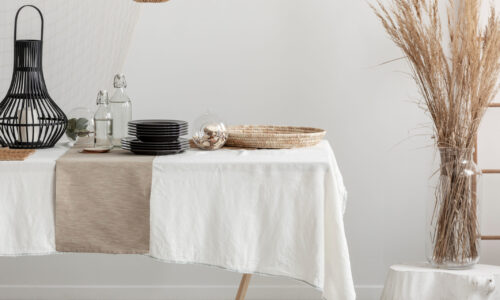The Best Lace Tablecloth

Our Review Process
Don't Waste Your Money is focused on helping you make the best purchasing decision. Our team of experts spends hundreds of hours analyzing, testing, and researching products so you don't have to. Learn more.
Our Picks For The Top Lace Tablecloths
- 1. Juvale Machine Washable Decorative Lace Tablecloth
- 2. Fowecelt Romantic Rose Lace Tablecloth
- 3. B-COOL Antique Wedding Eyelash Lace Tablecloth
- 4. ShinyBeauty Black Scalloped Edged Black Lace Tablecloth
- 5. Collections Etc Rose Machine Washable Lace Tablecloth
- 6. ARTABLE Formal Antique Flower Lace Tablecloth
- 7. Goldstream Point Floral Lace Overlay Tablecloth
When planning an event that's a bit more fancy, this lace tablecloth is the way to go. Not only does it feature a beautiful floral design, but the edges of the tablecloth are also scalloped for added style. You'll find it works best on rectangular tables, as it measures 60 by 97 inches.
A Touch of EleganceCleaning this lace tablecloth is a breeze, as it's machine washable.
Measuring 60 by 120 inches, this attractive lace tablecloth is designed to drape over your rectangular table. It's constructed from a high-quality lace that is sure to impress your guests. The embedded floral patterns make it a great choice for bridal showers, baby showers and even date night with that special someone.
Budget-Friendly OptionThanks to the affordable price tag on this lace tablecloth, you'll be able to decorate your table in style without spending a fortune.
This stunning lace tablecloth features a pretty rose design. It is made from high-quality lace that is soft and durable. Note that this tablecloth should be hand-washed for best results.
Exquisite Floral DesignThis eye-catching lace tablecloth has a classic rose pattern.
With beautiful fringe details, this black lace tablecloth has a formal and elegant appeal. It can be used as an overlay or on its own. The tablecloth is ideal for events and parties.
Lovely Fringe DetailsThis lace tablecloth has a delicate design that creates a formal look.
Buying Guide
Lace tablecloths bring an elegant and sophisticated look to your dining space. Lace is a versatile fabric that can work with both traditional and contemporary decorating styles, and it can be functional for both everyday meals and special events.
There are many different types of lace. One of the most popular varieties is Queen Anne’s lace, which includes floral patterns and bird imagery. Chantilly lace is another well-known kind of lace, and it’s often used for bridal fashions and formal tablecloths. It was originally used in clothing made for widows.
A cutwork style of lace includes holes within the pattern. This kind of lace is commonly used on tablecloths with a solid colored fabric underneath it. Quaker lace is a well-known variety that is typically used for curtains and tablecloths.
When selecting the style of lace for your tablecloth, consider the mood you want to create. Lace is typically available in white and shades of cream, which add a more traditional or country look. Some varieties are also available in black, which can appear more edgy and contemporary.
What to Look For
- The size and shape of your table will help you determine the size of the lace tablecloth that you’ll need. The tablecloth should cover the surface of the table and drop about 6 to 10 inches on each side. A more formal look is created by a long overhang, while casual tables have a short overhang of tablecloth. If you have a leaf for your table, keep this in mind when selecting your tablecloth size.
- Whether lace is made from cotton, linen or synthetic materials, it is a delicate fabric that needs to be cared for properly. Most lace tablecloths should be washed by hand in cold water with a mild detergent, and hung or laid flat to dry. Some lace tablecloths will be machine washable. Keep in mind that because lace is a delicate fabric, the material may snag in the washer and dryer. The heat from a dryer can also distort the shape of the fibers.
- If you need to iron your lace tablecloth, do not place the iron on the lace directly. Instead, use a thick towel in the same color as the lace, and place that between the iron and the tablecloth. This will protect the lace from any heat damage while still getting rid of wrinkles.
More to Explore
The history of lace dates back to the 15th century in Europe. It’s unclear whether lace was first invented in Italy or in the Flanders region, which is at the border of Belgium and France. Regardless of where it was first made, the technique that was used to make lace involved a complex system. In order to create the lacy look, threads were removed from woven cloth, which created open spaces in the pattern. These open sections were then reinforced with embroidery. Later on, a new technique was used that didn’t involve removing thread from fabric. Instead, lacemakers created open designs based on a pattern with no backing fabric.

















